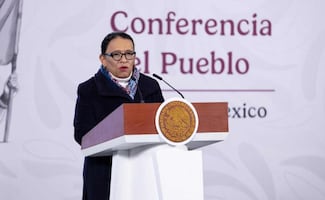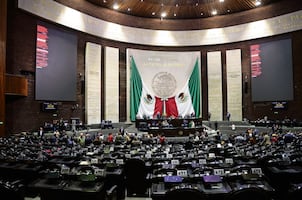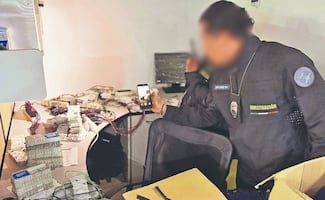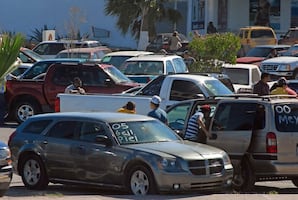Más Información

Segob: en administración de Trump retornaron más de 145 mil migrantes mexicanos; dan atención a connacionales con "México te abraza"

Alito Moreno afirma que México debe ser aliado de EU ante dictaduras como la de Maduro; "¡Venezuela libre ya!”
On November 4, 1799, Alexander Von Humboldt , was surprised by a strong earthquake , The explorer was laying on a hammock in Cumaná , in the coast of what is now Venezuela , when people started running. The occasion was unique for the scientist who, with a cold head, used his tools to measure the seismic wave . His surprise was portrayed in his diary: “For the first time, we have to mistrust the soil where we set out foot with trust for such a long time.”
Two centuries later, the same skepticism influences the work of seismologists such as Víctor Cruz Atienza , a researcher from the Geophysics Institute , who along with his team from Mexico's National Autonomous University (UNAM), and in collaboration with the Japanese government , is looking to understand the so-called Guerrero seismic gap , a region in the coast of the Pacific where a stronger earthquake than the one from 1985 could take place, which was the worst natural disaster in the history of Mexico .
A geologic whiplash
The 130-kilometers-long strip located in the Costa Grande of Guerrero , between Acapulco and Papamoa . These two towns were the epicenters of two of the most remembered earthquakes for the damages they caused: the fall of the Angel of the Independence in 1957 and the collapse of the Iberoamerican University in 1979. According to scientific calculations , the return or recurrence period in this region should be between 30 and 60 years; that is, that the energy accumulated should be released, more or less a few years in between, during this period of time.
Nevertheless, the Guerrero seismic gap hasn't presented a significant earthquake since December 16, 1911, when a 7.5 magnitude earthquake took place. That is, it's been over a century since a major earthquake took place in that seismic gap but also, a 100-kilometer-long strip has been added, near the border with Oaxaca , where a major earthquake hasn't taken place for 62 years.
Therefore, the experts are now talking about a threat that spreads through 230 kilometers in the Mexican subduction zone where one or several large-scale earthquakes could take place.
“It's like an elastic band. If you stretch it and stretch it until it can't stand it, it breaks. It gives me a whiplash because of the elasticity (…). The same happens in the rock . The continent is deformed and when it can no longer take it, it slides and that brusque movement of the geological fault is the one that generates the seismic waves ,” Cruz Atienza explains.
The understanding of the seismic danger for Mexico City has been based on harsh lessons. If the 1957 earthquake , with a 7.8 magnitude, was the birth of seismic engineering in the country and the creation of the first construction rules , and the 1979 earthquake , with a 7.6 magnitude, meant the adaptation of new parameters, it wasn't until 1985 when the vulnerability of the city was understood. “Then the seismic threat was understood in its whole dimension (…). The experts didn't know how strong could earthquakes be in Mexico City because there wasn't a historical record, there was no antecedent to be able to warn (about it),” says the researcher , who has been named as one of the best scientists in the world by Nature magazine in 2017.
According to calculations, the 1985 earthquake caused at least 10,000 human deaths; the official numbers say they were 4,541 , and 16,200 buildings were affected , 14% of which totally or partially collapsed, according to the then General Management for the Institute for the Security of Construction in the Federal District , and caused material losses for over USD $4,100 million . Despite everything, the tragedy translated into the creation of civil protection programs and the creation of the Seismic Alert System for Mexico City , the antecedent for the current Mexican Seismic Alert System , among other actions.
In regards to scientific matters, a seismometer network was created in Mexico City. An infrastructure that has gathered evidence to understand the power of the amplification of the seismic waves that take place in Mexico City as a consequence of the lacustrine origin of the soil, therefore, the seismic waves can be from 10 to 500 times more powerful than in places that are outside Mexico City 's valley.
Knowledge is prevention
Said information has been the foundation of different prevention policies, including, for example, more strict and specific rules and the creation of “maps of seismic microzoning with which, according to the Disaster Prevention Atlas from the CENAPRED , the different intensities of the movements that take place in several sites can be identified precisely and elaborate scenarios for different events.”
But the calculations of what could happen in the Guerrero seismic gap could exceed the experience of the 1985 earthquake . It's believed that the area accumulates a potential that could unleash an 8.2 magnitude earthquake . An earthquake whose seismic waves would impact Mexico City with an intensity two or three times more powerful than in 1985.
What does this represent one of the most populated metropolitan areas in the world? According to a document titled “Theoretical frame to identify initiatives to increase the earthquake resistance of a city,” an investigation where several agencies from Mexico City's local government participated along with 70 experts to evaluate its vulnerability, in Mexico City , there are 1.2 million plots registered in the land registry and from them, at least 7,500 are of high-risk so they can't be monitored individually because they present high-risk characteristics before an earthquake .
Nevertheless, it's not necessary to wait until something happens to implement measures since, as Cruz Atienza affirms, “the main input from where any preventive measure must start from is the quantification of the danger the threat implies.” I ask the scientist : “Do we have to know the size of the wolf?”. The answer is blunt: “Of course, to realize the size of the fence we need so it doesn't come in or what has to be done so that it doesn't harm us because if the wolf is tiny or if it's a squirrel, then we don't have to do anything but if it's big...”.
Seismogeodetic Amphibious Network
It is through sophisticated scientific instrumentation, known as the Seismogeodetic Amphibious Network , with which the team led by Cruz Atienza is trying to understand the subduction zone in the Mexican Pacific . It is an infrastructure formed by geodetic instruments , carefully placed in the bottom of the ocean as well as in the continental area, to parametrically monitor the deformation of a rock; and through seismological devices to measure the most minuscule continental tremors that allow measuring the s eismic potential. “The question that I frequently ask myself is: If an earthquake starts here, is it possible that it spreads and breaks all the gap ?” says the seismologist .
The operation, which will cost USD $7 million and will end in 2021 , is looking to provide an answer to specific questions that could bear good news, such as the role of slow earthquakes, which are movements that last six months , which could release energy from the seismic gap without causing any damage and extend the return period in the area; or bad news, such a the potential of tsunamis in the Pacific coast , a threat that isn't usually considered in Mexico but that is present.
“We're creating a series of scenarios of future earthquakes , which could possibly derive from the mapping of the seismic coupling between two tectonic plates . Then, very soon, we will have the first estimates of maps for marine-related hazards in the face of a future earthquake in the Guerrero seismic gap . (…) It's an essential input needed by the structural engineers to make buildings that aren't at risk,” he said.
An idea endorsed by Tomás Sánchez, for whom more knowledge about the seismic danger allows that buildings have certain security measures that prevent larger seismic damages and the loss of human lives. Are we ready for a huge earthquake emanated from the Guerrero seismic gap ?, I ask the head of the diffusion department of the CENAPRED .
“In the last years, there have been developments in the organization of the Civil Protection National System. Besides, there is legislation in this matter, funds for the prevention and attention of disasters , and technical and scientific institutions focused on the prevention, study, and monitoring of perturbing phenomena. But the economic losses registered in Mexico every year indicate that vulnerabilities increase, that's why it is necessary to move towards the fulfillment of the regulatory framework in regards to construction, land use, civil protection, the timely identification of risks, education, and the development of self-protection abilities,” he explained.
Earthquakes
are an ordinary phenomenon in Mexico , a threat under which we will live forever, says Cruz Atienza in his book “ Earthquakes, an everyday threat ,” a work where the researcher tried to present the complexity of the seismic issue in Mexico through a friendly language. “Then what can we do to live without fear of dying because of it (the seismic issue in Mexico)?,” wonders the author; “The answer, as difficult as it seems, is actually easy to articulate: understand the phenomenon and use this knowledge to reduce our vulnerability,” he concludes.
Translated by Gretel Morales
gm
Noticias según tus intereses
[Publicidad]
[Publicidad]















